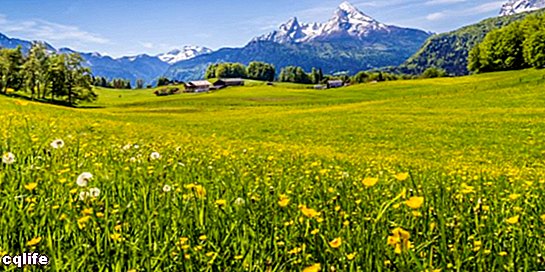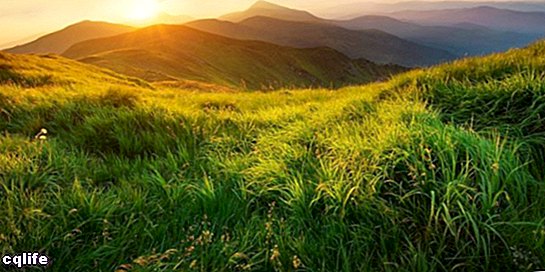- What is a meadow?
- Types of grasslands
- Geographical location of the grasslands
- Prairie weather
- Animals from the meadow
- Florafrom the meadow
- Agriculture and livestock on the prairie
We explain what a meadow is, the types of meadow that exist and their different climates. Also, how is the flora and fauna of this biome.

What is a meadow?
A meadow is a type of biome It is characterized by a temperate climate and a vegetation formed, in its majority, by grasses, bushes and few trees. Grasslands are open, flat terrain that is located in the central part of the continents and its climatic conditions are in the middle between the desert climate and the forested one.
There are two types of grasslands: tropical grasslands and temperate grasslands, which differ from each other according to climate, flora and fauna.
The prairie has rich soil, making it one of the most exploited and modified areas by the action of human being through the cultivation of corn, soybeans, wheat, cotton and the cattle raising.
About a quarter of the surface of the Earth It is covered with prairie and it is a biome that has different names depending on its geographical location: in the United States it is called “prairie”; in South America It is called "pampa"; in central Eurasia it is called "steppe" and in Africa it is called "bed sheet”.
Types of grasslands

Within the classification of this biome it is possible to differentiate two types of grasslands:
- Tropical grasslands. They are meadows characterized by a warm climate throughout the year and by having two distinct seasons: one dry and the other more humid. Its vegetation is usually abundant, with herbs that can measure several meters in height and a large presence of animals. The African savannas are an example of tropical grasslands.
- Temperate grasslands. They are meadows with annual rainfall between 250 and 750 mm, so their pastures or herbs are mainly grasses and do not reach great height. These meadows present a great fluctuation of temperature, with summers hot and cold winters, and can be found in North America and Argentina.
Geographical location of the grasslands
Grasslands are located in temperate zones, so they are not very close to the equator or the poles. Some of the grasslands are:
- Canadian Prairies. They extend to the south of Canada in the provinces of Alberta, Manitoba and Saskatchewan.
- Prairies in America. They extend in the center of the country in the states of Oklahoma, South Dakota, North Dakota, Kansas, Colorado, New Mexico, Texas, Nebraska, among others. Many are part of the Great Plains.
- Mexican grasslands. They extend in central and northern Mexico in the states of Chihuahua, Durango, Zacatecas, San Luis Potosí, among others.
- Grasslands in South America. They extend into Uruguay and a large part of central and southern Argentina.
- Grasslands in Eurasia. They extend through central Eurasia from Ukraine to Siberia in Russia. The great plain Hungarian is part of these grasslands.
Prairie weather
The climate of a meadow will depend on the geographical area in which it is located, since there are grasslands on all continents. Those that are closer to the equator have higher temperatures than those that are closer to the poles. Additionally, grasslands in the southern hemisphere tend to receive more rainfall than those in the northern hemisphere.
In tropical grasslands the climate is warm throughout the year and is marked by two seasons. The wet season of the prairie coincides with summer and receives large amounts of rainfall (more than 750 mm average per year), which allows the growth of herbs and grasses. On the contrary, the dry season corresponds to winter, it has warmer temperatures and it does not rain (which usually causes natural fires).
In temperate prairies there are two very well defined types of climate: one for winter and the other for summer. The climate in summer has temperatures around 21 ºC, while in winter it can reach an average of 11 ºC. This type of meadow receives rainfall throughout the year, with averages that do not exceed 750 mm per year, which only allows the growth of grasses and herbs (and not trees).
Animals from the meadow

Prairie animals usually vary according to the type of meadow, although they are mostly birds and herbivorous animals.
Rodents, vizcachas, hares, guinea pigs, maras, armadillos, mulitas, weasels, foxes and lizards inhabit the temperate plains of South America. As for birds, you can find rheas, owls, ducks, martinetas, chajáes, chimpanzees, teros, caranchos, horneros, cardinals, benteveos, calandrias, earwigs and hummingbirds.
A distinctive characteristic of the birds that live in the prairies is that, since there are not so many specimens of trees, they feed on the I usually and, for this reason, they have a brown or green coloration that serves to camouflage themselves.
Originally there were some predatory animals in the grasslands of South America but, due to the intervention of man in this ecosystem, many of these animals are in danger of extinction. Native to the grasslands of South America are the puma and the pampas deer.
To these native animals of the temperate prairies are added those introduced by man through livestock, such as cows, sheep and horses.
Animals such as the American badger, bison, striped skunk, and coyote can be found on the grasslands of North America.
The tropical grasslands of Africa are home to a large number of herbivorous animals, such as giraffes, zebras, elephants and antelopes, which feed on the grasses and grasses that grow in the summer. These animals tend to migrate to more humid areas during the dry season of the savannah. Are predators of these animals lions, hyenas, cheetahs, among others.
Insects and reptiles such as snakes, beetles, spiders, among others.
Florafrom the meadow
The flora of the prairie is not usually very abundant in variety of species, but in quantity. Prairie rainfall is not enough to form a Forest, but they are more humid than deserts, allowing the growth of grasses. Fires and the presence of agricultural activity are other reasons that hinder the growth of trees in this area.
In a meadow you can see reed beds, grasses and grasslands. The height of these grasses will depend on the type of meadow: the grasses of the tropical meadow are usually taller than those of the temperate meadow.
In temperate grasslands there are about 50 species of plants, mainly grasses, and many areas are occupied by cereal plantations, such as wheat, corn and sunflower. In tropical grasslands there are usually not as many crops and up to 200 species of plants.
Agriculture and livestock on the prairie
One of the main characteristics of the meadows is that they are constituted by a soil of the chernozem type. This soil is black and rich in minerals and in humus, which makes it an ideal environment for growing.
The type of climate and rainfall that the prairies receive during the year are other reasons that allow the development of the farming. Grains such as corn, sunflower, wheat, barley, soybeans, and rye are grown in temperate grasslands.
Due to the presence of grasses and low grasses, the meadows are also favorable areas for grazing animals, such as cows, horses, sheep and goats, which allows the development of livestock.
